1.14: Broth Based Soups
- Page ID
- 21163
\( \newcommand{\vecs}[1]{\overset { \scriptstyle \rightharpoonup} {\mathbf{#1}} } \)
\( \newcommand{\vecd}[1]{\overset{-\!-\!\rightharpoonup}{\vphantom{a}\smash {#1}}} \)
\( \newcommand{\id}{\mathrm{id}}\) \( \newcommand{\Span}{\mathrm{span}}\)
( \newcommand{\kernel}{\mathrm{null}\,}\) \( \newcommand{\range}{\mathrm{range}\,}\)
\( \newcommand{\RealPart}{\mathrm{Re}}\) \( \newcommand{\ImaginaryPart}{\mathrm{Im}}\)
\( \newcommand{\Argument}{\mathrm{Arg}}\) \( \newcommand{\norm}[1]{\| #1 \|}\)
\( \newcommand{\inner}[2]{\langle #1, #2 \rangle}\)
\( \newcommand{\Span}{\mathrm{span}}\)
\( \newcommand{\id}{\mathrm{id}}\)
\( \newcommand{\Span}{\mathrm{span}}\)
\( \newcommand{\kernel}{\mathrm{null}\,}\)
\( \newcommand{\range}{\mathrm{range}\,}\)
\( \newcommand{\RealPart}{\mathrm{Re}}\)
\( \newcommand{\ImaginaryPart}{\mathrm{Im}}\)
\( \newcommand{\Argument}{\mathrm{Arg}}\)
\( \newcommand{\norm}[1]{\| #1 \|}\)
\( \newcommand{\inner}[2]{\langle #1, #2 \rangle}\)
\( \newcommand{\Span}{\mathrm{span}}\) \( \newcommand{\AA}{\unicode[.8,0]{x212B}}\)
\( \newcommand{\vectorA}[1]{\vec{#1}} % arrow\)
\( \newcommand{\vectorAt}[1]{\vec{\text{#1}}} % arrow\)
\( \newcommand{\vectorB}[1]{\overset { \scriptstyle \rightharpoonup} {\mathbf{#1}} } \)
\( \newcommand{\vectorC}[1]{\textbf{#1}} \)
\( \newcommand{\vectorD}[1]{\overrightarrow{#1}} \)
\( \newcommand{\vectorDt}[1]{\overrightarrow{\text{#1}}} \)
\( \newcommand{\vectE}[1]{\overset{-\!-\!\rightharpoonup}{\vphantom{a}\smash{\mathbf {#1}}}} \)
\( \newcommand{\vecs}[1]{\overset { \scriptstyle \rightharpoonup} {\mathbf{#1}} } \)
\( \newcommand{\vecd}[1]{\overset{-\!-\!\rightharpoonup}{\vphantom{a}\smash {#1}}} \)
\(\newcommand{\avec}{\mathbf a}\) \(\newcommand{\bvec}{\mathbf b}\) \(\newcommand{\cvec}{\mathbf c}\) \(\newcommand{\dvec}{\mathbf d}\) \(\newcommand{\dtil}{\widetilde{\mathbf d}}\) \(\newcommand{\evec}{\mathbf e}\) \(\newcommand{\fvec}{\mathbf f}\) \(\newcommand{\nvec}{\mathbf n}\) \(\newcommand{\pvec}{\mathbf p}\) \(\newcommand{\qvec}{\mathbf q}\) \(\newcommand{\svec}{\mathbf s}\) \(\newcommand{\tvec}{\mathbf t}\) \(\newcommand{\uvec}{\mathbf u}\) \(\newcommand{\vvec}{\mathbf v}\) \(\newcommand{\wvec}{\mathbf w}\) \(\newcommand{\xvec}{\mathbf x}\) \(\newcommand{\yvec}{\mathbf y}\) \(\newcommand{\zvec}{\mathbf z}\) \(\newcommand{\rvec}{\mathbf r}\) \(\newcommand{\mvec}{\mathbf m}\) \(\newcommand{\zerovec}{\mathbf 0}\) \(\newcommand{\onevec}{\mathbf 1}\) \(\newcommand{\real}{\mathbb R}\) \(\newcommand{\twovec}[2]{\left[\begin{array}{r}#1 \\ #2 \end{array}\right]}\) \(\newcommand{\ctwovec}[2]{\left[\begin{array}{c}#1 \\ #2 \end{array}\right]}\) \(\newcommand{\threevec}[3]{\left[\begin{array}{r}#1 \\ #2 \\ #3 \end{array}\right]}\) \(\newcommand{\cthreevec}[3]{\left[\begin{array}{c}#1 \\ #2 \\ #3 \end{array}\right]}\) \(\newcommand{\fourvec}[4]{\left[\begin{array}{r}#1 \\ #2 \\ #3 \\ #4 \end{array}\right]}\) \(\newcommand{\cfourvec}[4]{\left[\begin{array}{c}#1 \\ #2 \\ #3 \\ #4 \end{array}\right]}\) \(\newcommand{\fivevec}[5]{\left[\begin{array}{r}#1 \\ #2 \\ #3 \\ #4 \\ #5 \\ \end{array}\right]}\) \(\newcommand{\cfivevec}[5]{\left[\begin{array}{c}#1 \\ #2 \\ #3 \\ #4 \\ #5 \\ \end{array}\right]}\) \(\newcommand{\mattwo}[4]{\left[\begin{array}{rr}#1 \amp #2 \\ #3 \amp #4 \\ \end{array}\right]}\) \(\newcommand{\laspan}[1]{\text{Span}\{#1\}}\) \(\newcommand{\bcal}{\cal B}\) \(\newcommand{\ccal}{\cal C}\) \(\newcommand{\scal}{\cal S}\) \(\newcommand{\wcal}{\cal W}\) \(\newcommand{\ecal}{\cal E}\) \(\newcommand{\coords}[2]{\left\{#1\right\}_{#2}}\) \(\newcommand{\gray}[1]{\color{gray}{#1}}\) \(\newcommand{\lgray}[1]{\color{lightgray}{#1}}\) \(\newcommand{\rank}{\operatorname{rank}}\) \(\newcommand{\row}{\text{Row}}\) \(\newcommand{\col}{\text{Col}}\) \(\renewcommand{\row}{\text{Row}}\) \(\newcommand{\nul}{\text{Nul}}\) \(\newcommand{\var}{\text{Var}}\) \(\newcommand{\corr}{\text{corr}}\) \(\newcommand{\len}[1]{\left|#1\right|}\) \(\newcommand{\bbar}{\overline{\bvec}}\) \(\newcommand{\bhat}{\widehat{\bvec}}\) \(\newcommand{\bperp}{\bvec^\perp}\) \(\newcommand{\xhat}{\widehat{\xvec}}\) \(\newcommand{\vhat}{\widehat{\vvec}}\) \(\newcommand{\uhat}{\widehat{\uvec}}\) \(\newcommand{\what}{\widehat{\wvec}}\) \(\newcommand{\Sighat}{\widehat{\Sigma}}\) \(\newcommand{\lt}{<}\) \(\newcommand{\gt}{>}\) \(\newcommand{\amp}{&}\) \(\definecolor{fillinmathshade}{gray}{0.9}\)Consommé
In cooking, a consommé is a type of clear soup made from richly flavored stock, or bouillon that has been clarified, a process that uses egg whites to remove fat and sediment.
A consommé is made by adding a mixture of ground meats, together with mirepoix (a combination of carrots, celery, and onion), tomatoes, and egg whites into either bouillon or stock. The key to making a high quality consommé is simmering; the act of simmering, combined with frequent stirring, brings impurities to the surface of the liquid, which are further drawn out due to the presence of acid from the tomatoes. Eventually, the solids begin to congeal at the surface of the liquid, forming a 'raft', which is caused by the proteins in the egg whites.
Once the 'raft' begins to form, the heat is reduced, and the consommé is simmered at a lower heat until it reaches the desired flavor, which usually takes anywhere from 45 minutes to over an hour. The resulting concoction is a clear liquid that has either a rich amber color (for beef or veal consommé) or a very pale yellow color (for poultry consommé). It is then carefully drawn from the pot and passed again through a filter to ensure its purity, and is then put through a lengthy process where all of the visible fat is skimmed from the surface.
To ensure total purification, the consommé can be refrigerated, which draws out remaining fat, which can easily be skimmed off with a cheesecloth. Alternatively, the consommé can be placed in a wide, shallow container such as a sauté pan or large bowl and wide strips of parchment paper can be dragged along the surface; the tiny amounts of remaining fat adhere to the parchment, leaving the consommé perfectly de-greased. Cartilage and tendons should be left on the meat because of the gelatin they contain, which enhances the mouthfeel of the soup. If beef or veal is used, shin meat is ideal[4] because it is very low in fat and very high in gristle, and although it is undesirable for most other purposes, it is near essential for the flavor of the consommé. The meat is best if it is ground very fine, as if for a mousseline.
Consommés are usually served piping hot because they tend to cool down more quickly than other soups and form a gel. They are most often served with garnishes, which vary in complexity from a simple splash of sherry or egg yolk, to cut vegetables, to shaped savory custards called 'royales'.
A large amount of meat only yields a small amount of consommé. In some recipes, as much as 500 g (a little over a pound) of meat can go into a single 250 mL (8.2 fl. oz.) serving. This low-yield is part of what has traditionally given consommé its refined reputation as a dish fit for the higher levels of society and not consumed among the poorer classes, who could not afford such extravagance.[citation needed]
Other types of consommé such as a tomato consommé are traditionally served chilled; this keeps the clearness of the consommé.
Oignon Brule (onion brulé) - French for burnt onion, made by charring halves. It is used to flavor and color stocks and sauces
In addition to consommé, there are many other broth based soup variations. The broth based soup category consists of any soup that is prepared with broth. Some examples of broth-based soups are minestrone, chicken tortilla, French onion and the Vietnamese soup, Pho. These are some soups that we prepare in class.
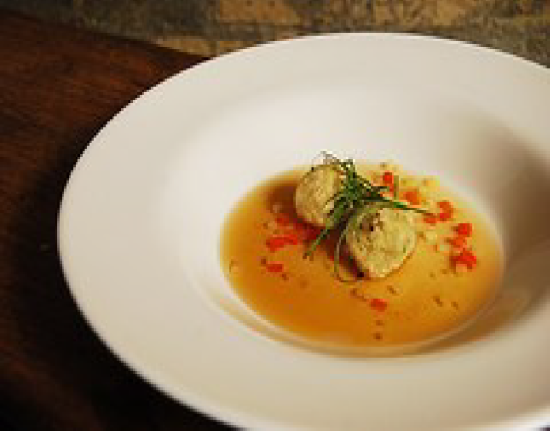
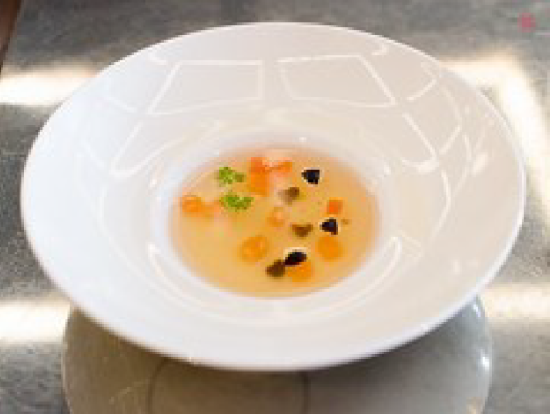
Consomme plate up examples. Photo Credit: Flikr
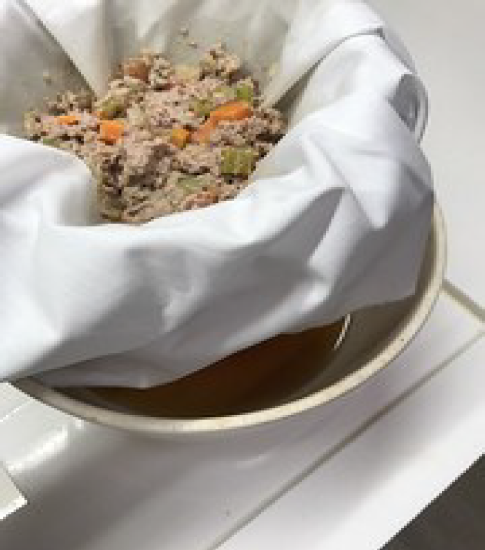
The straining of the raft in the consomme procedure.
Photo Credit: Flikr
French Onion Soup
Onion soups have been popular at least as far back as Roman times. Throughout history, they were seen as food for poor people, as onions were plentiful and easy to grow. The modern version of this soup originates in Paris, France in the 18th century, made from beef broth, and caramelized onions. It is often finished by being placed under a grill in a ramekin with croutons and gruyere melted on top. Recipes for onion soup vary greatly. Recipes specify that the onions should be cooked slowly, becoming caramelized. Brandy or sherry is added at the end. The soup base is often topped with a slice of bread (a "croute" or "crouton").
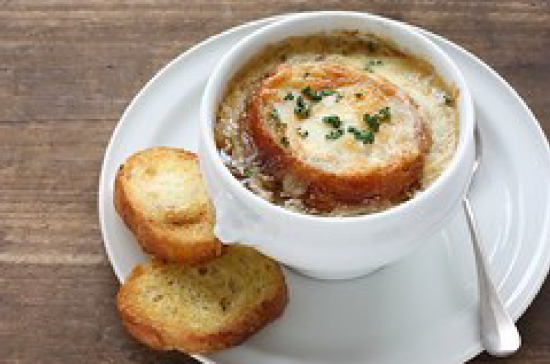
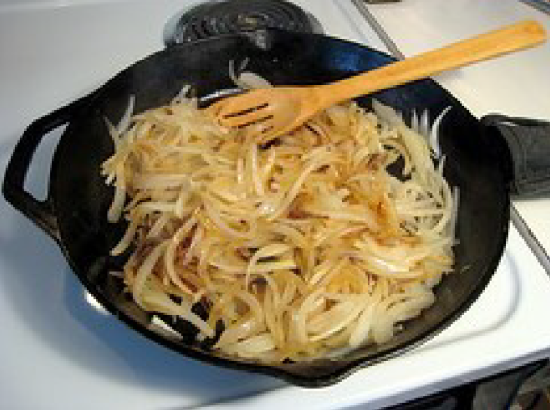
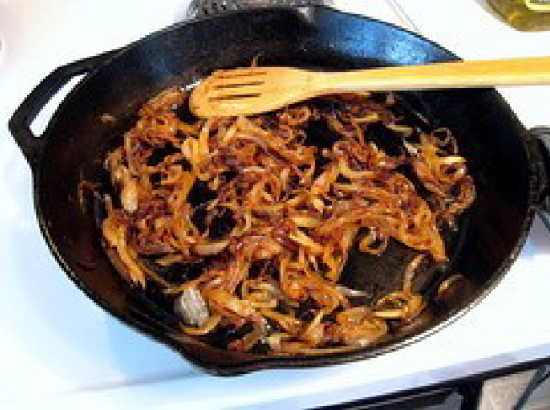
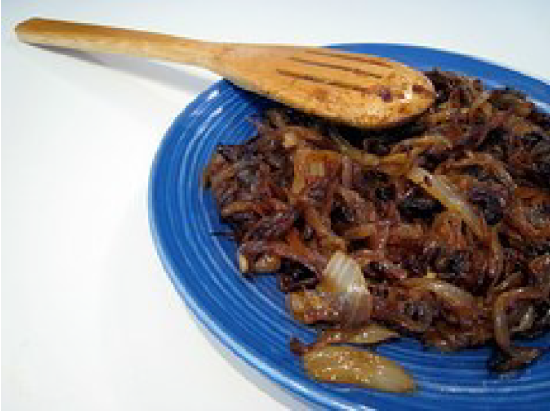
It is important to caramelize onions to a deep brown color. Photo Credit: Flikr
Pho
Pho is a popular street food in Vietnam and a specialty in a number of restaurant chains around the world. Pho originated in the early 20th century in northern Vietnam, and was popularized throughout the rest of the world by refugees after the Vietnam War.
Pho is served in a bowl with a specific cut of flat rice noodles in clear beef broth, with thin cuts of beef (steak, fatty flank, lean flank, brisket). Variations feature slow-cooked tendon, tripe, or meatballs in southern Vietnam. Chicken pho is made using the same spices as beef, but the broth is made using chicken bones and meat, as well as some internal organs of the chicken, such as the heart, the undeveloped eggs, and the gizzard.
When eating at ‘phở stalls’ in Vietnam, customers are generally asked which parts of the beef they would like and how they want it done.
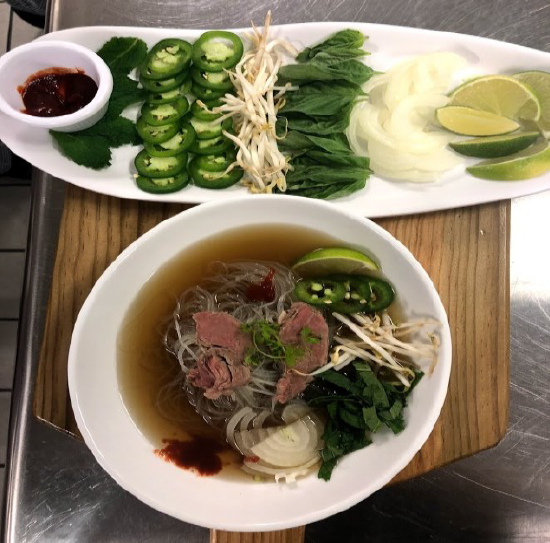
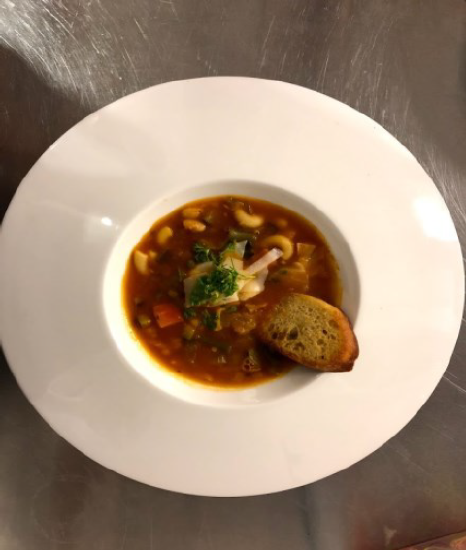
Pho plate up example Minestrone soup plate up example
Photo Credit: Amelie Zeringue


